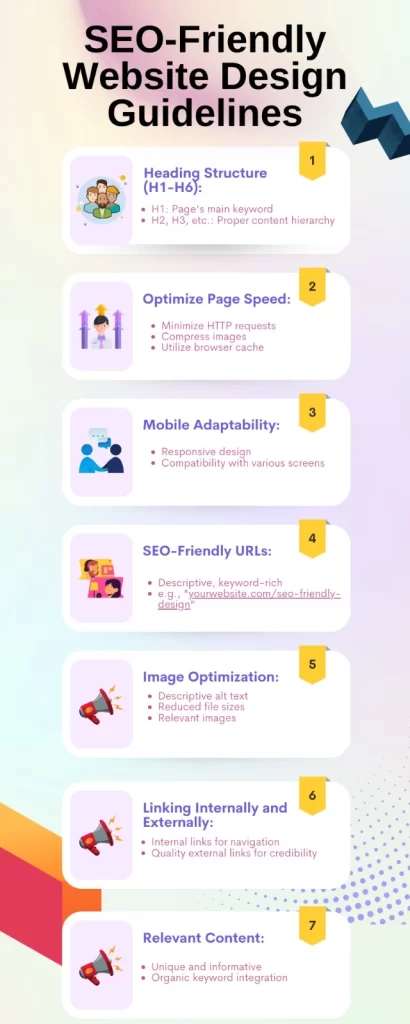A website’s aesthetic appeal alone is insufficient. Your website must be SEO-friendly in order to make its presence felt and enhance organic traffic. It’s critical to integrate your website structure with SEO best practices because search engines are constantly improving their algorithms. In this article, we’ll look at the rules for designing websites that are compatible with search engines in order to improve website traffic and search engine rankings.

- Heading Structure (H1-H6)
Make sure your headers have a clear structure. The H1 tag should include the page’s principal keyword and highlight the core subject matter, followed by H2, H3, and beyond to properly order the information.
- Increase Web Page Loading Efficiency
SEO rankings may be harmed by a website that loads slowly. To reduce the amount of HTTP requests and speed up the loading process, compress images and make use of browser cache.
- Mobile adaptability
Your website should be mobile-responsive in the era of mobile devices. Search engines like Google and others give mobile-adaptive websites preference. Make sure that the design works with a range of screen sizes and specifications.
- SEO-friendly URLs
Create user-friendly URLs that are descriptive and contain relevant keywords. It is recommended to use URLs like “yourwebsite.com/seo-friendly-design” instead of generic ones like “yourwebsite.com/page123.”
- Image Optimization
Add descriptive alt language, minimize file dimensions, and make sure pictures are appropriate for the content to optimize them. This upgrades SEO and the user experience.
- Linking Internally and Externally
To help consumers and web crawlers navigate your site, include internal links to other sites. Likewise where appropriate, include reputable external connections to help your site’s reliability.
- Relevant Content
Create unique, informative content that meets the demands of your intended audience. Include key phrases organically, but avoid overuse of keywords.
Also Read: What Makes the Title Tag Important
How to Know if Your Website is SEO optimized
- Keyword Research: Are you aiming for appropriate phrases associated with user intent?
- Mobile-Friendly Test: Use the Mobile-Friendly Test provided by Google to guarantee your website is mobile responsive.
- Page Performance Insights: Use Page Speed Insights from Google to assess your website’s loading performance and apply any necessary changes.
- User Experience (UX): To improve the design of your website, examine user behavior, cancellation rates, and conversion rates.
- Google Search Console: Use this resource to keep track of the status of your website, correct crawl issues, and submit sitemaps.
Conclusion
The exposure and rating of the website on search engines can be positively impacted by applying these SEO-friendly website design concepts. Keep in mind that SEO is a never-ending endeavor, and that adhering to recommended practices is crucial for success over the long term in the world of technology.
